
The population counts of Quirino Province by municipality and barangay, as determined by the 2024 Census of Population (POPCEN), were officially declared for all purposes through Proclamation No. 973, signed by President Ferdinand R. Marcos, Jr. on 11 July 2025. This proclamation was issued in accordance with Republic Act No. 10625 (Philippine Statistical Act of 2013) and Executive Order No. 87, s. 2025.
As of 01 July 2024, Quirino Province recorded a total population of 210,841, accounting for approximately 5.58% of the Cagayan Valley Region’s total population of 3,777,608. This figure reflects an increase of 7,013 persons from the 2020 population of 203,828, and 21,850 persons from the 2015 population of 188,991. Compared to 2010, the population rose by 34,055 persons from 176,786. (Table 1)
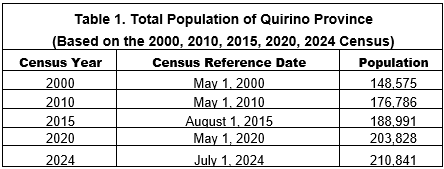
The total population of Quirino Province grew at an average annual rate of 0.81% between 2020 and 2024. This represents a slowdown compared to the 1.60% growth rate recorded during the 2015 to 2020 period. (Figure 1)
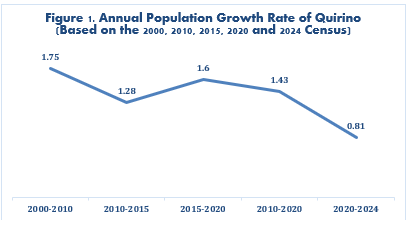
Quirino is composed of six (6) municipalities, with Diffun emerging as the most populous in 2024, registering 58,254 residents. It was followed by Maddela with 41,867 persons, Cabarroguis (the provincial capital) with 34,720, Aglipay with 31,596, and Nagtipunan with 26,541. Saguday recorded the smallest population among the six, with 17,863 residents. (Table 2)
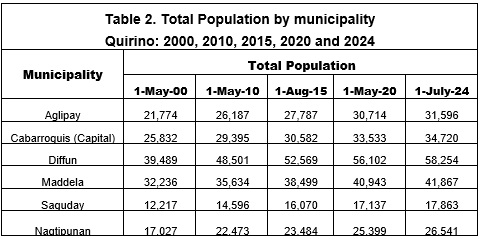
With a total land area of approximately 2,319.66 square kilometers, Quirino posted a population density of 91 persons per square kilometer in 2024. This represents an increase of 27 persons per square kilometer from the 64 persons per square kilometer recorded in 2000. (Table 3)
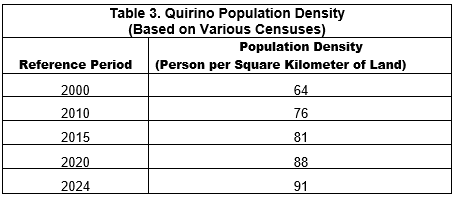
Examining longer-term trends, the province’s average annual growth rate from 2010 to 2015 was slightly lower at 1.28 percent. Among the municipalities, Nagtipunan recorded the fastest population growth between 2020 and 2024, with an annual Population Growth Rate (PGR) of 1.06 percent. It was followed by Saguday (1.00 percent), Diffun (0.91 percent), Cabarroguis (0.84 percent), and Aglipay (0.68 percent). Maddela registered the lowest PGR during the same period at 0.54 percent. (Table 4)
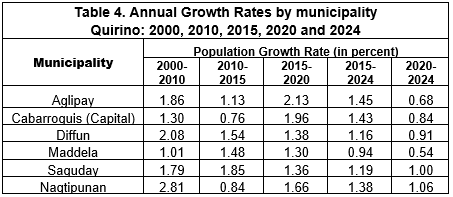
The Province of Quirino is composed of 132 barangays. Among them, Barangay Gundaway in the municipality of Cabarroguis recorded the highest population with 4,545 residents, based on the 2024 Census of Population. This was followed closely by Barangay Rizal in Diffun with 4,338 residents, and Barangay San Dionisio II in Nagtipunan with 4,144 residents. Rounding out the top ten most populous barangays is Barangay Magsaysay in Saguday, with 3,251 residents. (Figure 2)
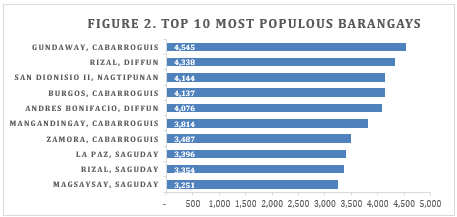
In contrast, Barangay Rang-ayan in Aglipay registered the lowest population in the province, with only 304 residents. It was followed by Villa Agullana in Maddela with 528 residents, and San Salvador, also in Maddela, with 537 residents. Completing the list of the ten least populous barangays is Barangay Ysmael in Maddela, with 642 residents. (Figure 3)
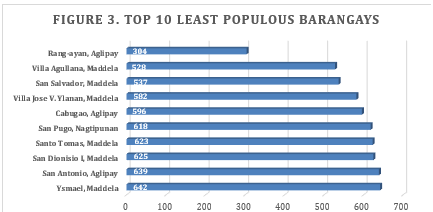
TECHNICAL NOTES
Total population is the sum of the household population and institutional population as of 12:01AM on 01 July 2024. It also includes Filipinos in Philippine embassies, consulates and missions abroad.
Population Growth Rate is the change in the number of individuals over a specific period of time.
Population Density is the average number of individuals per unit of area or volume.
Reference period is as of 12:01am of 01 July 2024.
The 2024 Census of Population was undertaken by the Philippine Statistics Authority pursuant to Republic Act No. 10625, also known as the Philippine Statistical Act of 2013, Executive Order No. 352 – Designation of Statistical Activities That Will Generate Critical Data for Decision-Making of the Government and the Private Sector, and Batas Pambansa (BP) Bilang 72, which provides the basis for the decennial conduct of the integrated census of population and housing.
The PSA extends its deepest appreciation to the public for their continued support and participation in the 2024 POPCEN. This census marks the 16th Census of Population in the Philippines since the first census in 1903.
Sources:
Philippine Statistics Authority, 2020 Census of Population and Housing
Philippine Statistics Authority, 2010 Census of Population and Housing
Philippine Statistics Authority, 2015 Census of Population
Philippine Statistics Authority, 2020 Census of Population and Housing
Philippine Statistics Authority, 2024 Census of Population
Approved for Release:
ENGR. CHERRY GRACE D. AGUSTIN
Chief Statistical Specialist
//ktf
